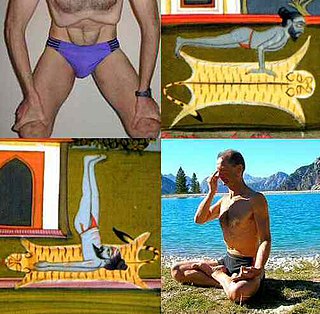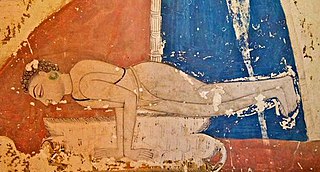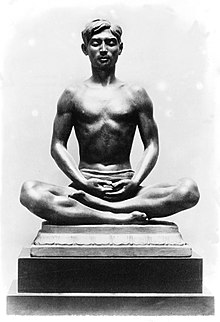
Hatha yoga is a branch of yoga which uses physical techniques to try to preserve and channel the vital force or energy. The Sanskrit word हठ haṭha literally means "force", alluding to a system of physical techniques. Some hatha yoga style techniques can be traced back at least to the 1st-century CE, in texts such as the Hindu Sanskrit epics and Buddhism's Pali canon. The oldest dated text so far found to describe hatha yoga, the 11th-century Amṛtasiddhi, comes from a tantric Buddhist milieu. The oldest texts to use the terminology of hatha are also Vajrayana Buddhist. Hindu hatha yoga texts appear from the 11th century onwards.
In Sanskrit texts, Rāja yoga was both the goal of yoga and a method to attain it. The term also became a modern name for the practice of yoga in the 19th-century when Swami Vivekananda gave his interpretation of the Yoga Sutras of Patanjali in his book Raja Yoga. Since then, Rāja yoga has variously been called aṣṭāṅga yoga, royal yoga, royal union, sahaja marg, and classical yoga.

The Haṭha Yoga Pradīpikā is a classic fifteenth-century Sanskrit manual on haṭha yoga, written by Svātmārāma, who connects the teaching's lineage to Matsyendranath of the Nathas. It is among the most influential surviving texts on haṭha yoga, being one of the three classic texts alongside the Gheranda Samhita and the Shiva Samhita.

The shatkarmas, also known as shatkriyas, are a set of Hatha yoga purifications of the body, to prepare for the main work of yoga towards moksha (liberation). These practices, outlined by Svatmarama in the Haṭha Yoga Pradīpikā as kriya, are Netī, Dhautī, Naulī, Basti, Kapālabhātī, and Trāṭaka. The Haṭha Ratnavali mentions two additional purifications, Cakri and Gajakarani, criticising the Hatha Yoga Pradipika for only describing the other six.

Kumbhaka is the retention of the breath in the yoga practice of pranayama. It has two types, accompanied whether after inhalation or after exhalation, and, the ultimate aim, unaccompanied. That state is kevala kumbhaka, the complete suspension of the breath for as long as the practitioner wishes.

Dhanurasana is a back bending asana in hatha yoga and modern yoga as exercise.

Siddhasana or Accomplished Pose, is an ancient seated asana in hatha yoga and modern yoga as exercise suitable for meditation. The names Muktasana and Burmese position are sometimes given to the same pose, sometimes to an easier variant, Ardha Siddhasana. Svastikasana has each foot tucked as snugly as possible into the fold of the opposite knee.
Shiva Samhita is a Sanskrit text on yoga, written by an unknown author. The text is addressed by the Hindu ascetic Shiva to his consort Parvati. The text consists of five chapters, with the first chapter a treatise that summarizes nondual Vedanta philosophy with influences from the Sri Vidya school of South India. The remaining chapters discuss yoga, the importance of a guru (teacher) to a student, various asanas, mudras and siddhis (powers) attainable with yoga and tantra.

Basti is an important shatkarma, a yogic purification, intended to clean the lower abdomen, especially the colon. The Hatha Yoga Pradipika and other sources attribute to it many beneficial effects. There are two ways to perform Basti:
Mandukasana, or Frog posture is a group of seated asanas in Hatha yoga and modern yoga as exercise, all of which put the body in a shape like that of a frog. Another frog-like posture is Bhekasana.
The Joga Pradīpikā is a hatha yoga text by Ramanandi Jayatarama written in 1737 in a mixture of Hindi, Braj Bhasa, Khari Boli and forms close to Sanskrit. It presents 6 cleansing methods, 84 asanas, 24 mudras and 8 kumbhakas. The text is illustrated in an 1830 manuscript with 84 paintings of asanas, prepared about a hundred years after the text.
Vajroli mudra, the Vajroli Seal, is a practice in Hatha yoga which requires the yogin to preserve his semen, either by learning not to release it, or if released by drawing it up through his urethra from the vagina of "a woman devoted to the practice of yoga".

Yoga Makaranda, meaning "Essence of Yoga", is a 1934 book on hatha yoga by the influential pioneer of yoga as exercise, Tirumalai Krishnamacharya. Most of the text is a description of 42 asanas accompanied by 95 photographs of Krishnamacharya and his students executing the poses. There is a brief account of practices other than asanas, which form just one of the eight limbs of classical yoga, that Krishnamacharya "did not instruct his students to practice".

The Vasishtha Samhita is a 13th century medieval Vaishnavite text, one of the first to describe non-seated hatha yoga asanas including the arm-balancing Kukkutasana, Cockerel Pose. It makes use of the 10th century Vimanarcanakalpa, whose verse it paraphrases in prose to describe what may be the first non-seated asana, the arm-balancing Mayurasana, Peacock Pose. These descriptions in turn were exploited by the 15th century Hatha Yoga Pradipika.

The Vivekamārtaṇḍa is an early Hatha yoga text, the first to combine tantric and ascetic yoga. Attributed to Goraknath, it was probably written in the 13th century. It emphasises mudras as the most important practice. The name means "Sun of Discernment". It teaches khecarīmudrā, mahāmudrā, viparītakaraṇī and the three bandhas. It teaches six chakras and the raising of Kundalinī by means of "fire yoga" (vahniyogena).
The Dattātreyayogaśāstra, a Vaisnava text probably composed in the 13th century CE, is the earliest text which provides a systematized form of Haṭha yoga under that name, and the earliest to place its yoga techniques under the name Haṭha.
The Yogabīja is an early Haṭha yoga text, from around the 14th century. It was the first text to propose the derivation of haṭha from the Sanskrit words for sun and moon, with multiple esoteric interpretations.
The Khechari Vidya, an early tantric text on Hatha yoga written around the 14th century, teaches only khecarīmudrā, one of several yogic seals or mudras, and is a major source for that method. This was meant to give the yogin access to stores of amrita in the body, and to raise Kundalinī via the six chakras.

The Gorakṣaśataka is an early text on Haṭha yoga text from the 11th-12th century, attributed to the sage Gorakṣa. It was the first to teach a technique for raising Kundalini called "the stimulation of Sarasvati", along with elaborate pranayama, breath control. It was written for an audience of ascetics.













